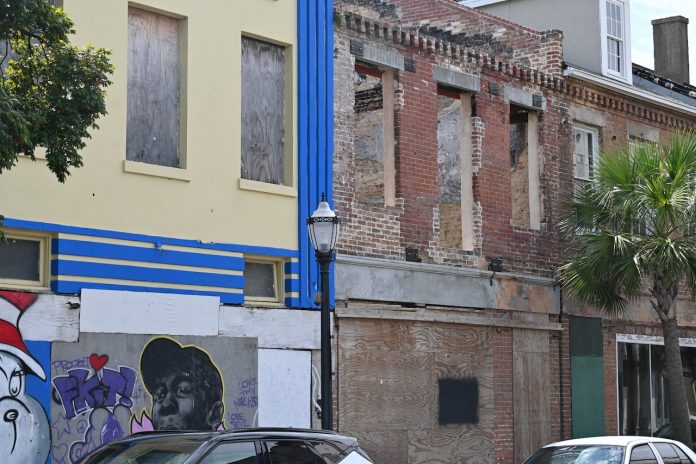Alabama’s second largest city stepped forward Tuesday in its fight against blight in the heart of downtown, adopting an ordinance that creates Mobile’s first registry for empty buildings.
In a 5-1 vote, the Mobile City Council approved the vacant property ordinance for commercial structures within the Henry Aaron Loop. The area is defined by a boundary that includes properties south and west of Beauregard Street and areas marked by Broad, Canal and Water streets.
The decision capped three months of debate and revisions over a system city officials hope will pressure long-time property holders to revive empty storefronts that have lingered in downtown Mobile for years.
“There was a lot of give and take to get to this point, but that’s what meaningful legislation often requires,” Mobile Mayor Spiro Cheriogotis said in a statement to AL.com. “So many people have invested their time, talent, and resources into making downtown what it is today. Like most Mobilians, they want a safer, more vibrant city center, and this ordinance helps us get there.”
Fred Rendfrey, president and CEO of the Downtown Mobile Alliance, said his organization generally supports the concept but is still reviewing how the measure might affect both the city and property owners.
“At the end of the day, I think we all have a vision for a vibrant downtown,” he said. “Vacancy and blight are killers. We’d like to see the city have more tools in their toolbox and I think the city has been moving in the right direction.”
Rendfrey pointed to the renewal of a tax increment financing district in downtown Mobile and the use of grants to repair or refresh building facades as tools already in place to help spur investment. A TIF district channels new property tax revenue generated within its boundaries back into public services in the same area.
The new registry, used in about 500 cities nationwide, requires owners of vacant structures to register their properties with a city code official within 30 days of becoming empty unless the building qualifies for an exemption.
Exemptions include public buildings, properties actively marketed within the past six months, buildings under construction or renovation, structures vacated because of fire or storm damage and mixed-use buildings where at least 20 percent of the floor area remains occupied.
Each owner of a vacant structure will pay a fee based on the building’s size and the number of years it has remained empty. A commercial property without residential units will carry a first-year fee of $500 or 5 cents per square foot, whichever is greater. The fee will rise to $2,000 by the fourth year.
City officials hope the fees will encourage owners to market neglected properties and help reduce blight downtown. About 140 buildings within the Henry Aaron Loop are currently vacant.
Councilman Ben Reynolds cast the lone “no” vote, saying the ordinance was poorly written and unlikely to work. He pushed for an amendment that would have shifted the responsibility to register properties from owners to city staff.
“I worry about its effectiveness,” Reynolds said. “Someone could use a property a short period of time throughout the year and satisfy this law. If someone uses (a vacant property) for one or two days, and keeps the power on, you are not affecting an outcome.”
Reynolds’ amendment failed with only two votes, his and that of Councilman Josh Woods.
Woods said he believes an educational campaign must accompany the new registry. He and Reynolds expressed concern that owners may not be aware of the new requirements.
Speaking to city staff, Woods said they will need to “work with title companies, Realtors” and others to get the word out.
“There is some effort that needs to be done to educate our community,” Woods said, adding that the ordinance establishes a program to identify vacant properties.
If you purchase a product or register for an account through a link on our site, we may receive compensation. By using this site, you consent to our User Agreement and agree that your clicks, interactions, and personal information may be collected, recorded, and/or stored by us and social media and other third-party partners in accordance with our Privacy Policy.







